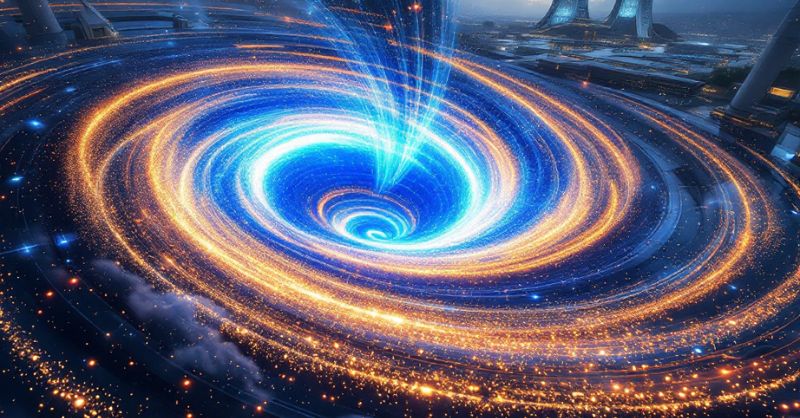
Antimatter, often depicted as the counterpart to the matter constituting our universe, presents a captivating enigma in modern physics. For every particle of matter, there exists an antiparticle with identical mass but opposite charge.
A quintessential example is the positron, the antimatter equivalent of the electron, bearing a positive charge instead of a negative one. When matter and antimatter particles encounter each other, they annihilate in a flash of pure energy, as described by Einstein’s equation, E=mc². This phenomenon underscores antimatter as the most energy-dense substance known.
The nature of Antimatter
Antiparticles mirror their matter counterparts in mass but possess opposite charges and quantum numbers. For instance, while protons carry a positive charge, their antiparticles, antiprotons, carry a negative charge. Similarly, electrons are negatively charged, whereas positrons are their positively charged antiparticles. The interaction between a particle and its corresponding antiparticle leads to annihilation, resulting in the release of energy predominantly in the form of gamma rays. This process exemplifies the complete conversion of mass into energy, highlighting the profound implications of Einstein’s mass-energy equivalence principle.
Production and detection of Antimatter
In the natural cosmos, antimatter is produced during high-energy events such as cosmic ray interactions and certain types of radioactive decay. On Earth, scientists replicate these conditions using particle accelerators.
The European Organization for Nuclear Research (CERN), housing the Large Hadron Collider (LHC), is at the forefront of such endeavors. By accelerating protons to near light speed and inducing collisions, the LHC recreates energy densities akin to those just after the Big Bang, resulting in the creation of various particles, including antiparticles.
Detecting antimatter involves identifying the unique signatures left by annihilation events. When antimatter comes into contact with matter, their annihilation produces gamma rays with specific energy levels. Instruments like scintillation detectors and cloud chambers are employed to observe these gamma rays, enabling researchers to confirm the presence of antimatter.
The matter-antimatter asymmetry
A profound mystery in cosmology is the apparent scarcity of antimatter in the observable universe. The prevailing cosmological models suggest that the Big Bang should have produced equal amounts of matter and antimatter. If this were the case, mutual annihilation would have ensued, leaving behind a universe filled predominantly with radiation. However, the observable universe is overwhelmingly composed of matter, with antimatter being exceedingly rare. This discrepancy is referred to as the matter-antimatter asymmetry.
One leading hypothesis to explain this asymmetry involves CP violation, where the laws of physics apply differently to matter and antimatter. Experiments, such as those conducted by the LHCb collaboration at CERN, have provided precise measurements of CP violation in the decays of certain particles, offering insights into the mechanisms that might have favored matter over antimatter in the early universe.
Potential applications of Antimatter
The immense energy released during matter-antimatter annihilation positions antimatter as a theoretical candidate for high-energy applications, notably in space propulsion. A spacecraft powered by controlled matter-antimatter reactions could, in theory, achieve velocities far surpassing those attainable by conventional chemical rockets, potentially enabling interstellar travel. However, the practical realization of such technology faces significant hurdles, primarily related to production, storage, and cost.
Why does Antimatter cost so much
Producing antimatter is an extraordinarily resource-intensive process. Facilities like CERN’s Antiproton Decelerator can produce only minute quantities of antimatter annually. The production of a single gram of antimatter is estimated to cost between $62.5 trillion and $2,700 trillion, depending on the specific type of antiparticle and production method. This astronomical cost is attributed to the sophisticated technology, substantial energy requirements, and the intricate processes involved in antimatter production.
Moreover, storing antimatter presents formidable challenges. Since antimatter annihilates upon contact with matter, it must be contained in a vacuum, suspended using electromagnetic fields to prevent it from touching the walls of the containment vessel. Developing and maintaining such containment systems are both technically demanding and costly, further complicating the practical use of antimatter.
What we think about it
Antimatter captivates the imagination, bridging the realms of theoretical physics and science fiction. Its study not only deepens our understanding of the fundamental symmetries and asymmetries of the universe but also challenges our technological capabilities.
While the practical applications of antimatter, such as in energy production or space travel, remain speculative due to current technological and economic constraints, ongoing research continues to shed light on its properties and potential. The pursuit of knowledge about antimatter exemplifies humanity’s relentless quest to comprehend the universe’s deepest mysteries, holding promise for future breakthroughs that could one day transform these theoretical concepts into reality.



